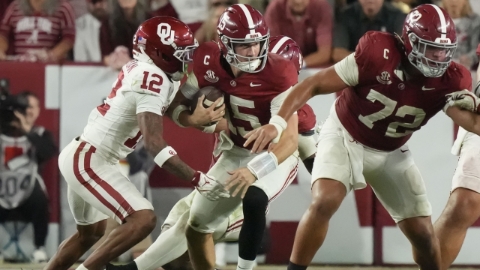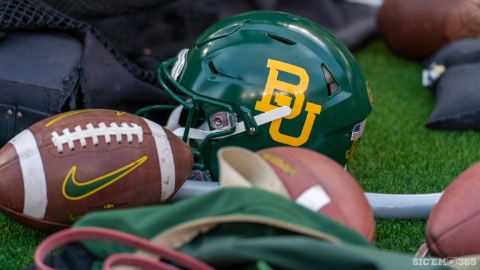Baylor football a sleeping giant? Hiccups in history, key momentum say its possible

There’s no better indication that the summer months have arrived than when you see generic and bland articles on front pages everywhere as college football analysts look deep into the roster, set an unreasonable depth chart before that roster is finalized and then break down the schedule to identify the most winnable games on the schedule.
A few more pieces will hit the rotation to be sure, but it’s the same ole space eating, constantly regurgitated information that will get clicks every single time.
But I want to do something a little different to kick off the summer months. And that’s to tell you why Baylor football could be a sleeping giant in college football. That’s a little clickbaity, to be fair, but someone will have to prove to me otherwise in a well thought out manner.
I’m stubborn, so good luck.
The History: Two bad stretches define Baylor’s history
With a 607-578-44 all-time record dating back to 1899, Baylor football spent the majority of its history playing average to bad football with numerous exceptions along the way.
From 1914 to 1940, Baylor recorded a 148-96 record under three head coaches: Charles P. Mosley (1914-1919), Frank Bridges (1920-1925) and Morley Jennings (83-60). The 60.7% winning percentage over the 26-year span was the highlight of the program at the time and is arguably the best long-term stretch in terms of consistency the program has ever seen.
The second World War began ahead of the 1939 season and continued over the next six years. During that stretch, Baylor would compile a record of 15-23 with the University not fielding a team for the 1943 and 1944 seasons. Bob Woodruff would take the program over in 1947 and remain the head coach for three seasons, restarting the successful era of Baylor football that was put on pause with the war.
From 1947 to 1956, Baylor posted a 66.7% winning percentage while winning 66 games, far exceeding the all-time winning percentage of the program. A 1956 Sugar Bowl win capped the era off, but also led to what might be the second-most damaging stretch to the program ever and one that foreshadowed greatly what was to come nearly 40 years later.
Over the next 15 seasons, Baylor won just 58 games against 94 losses. Compared to the 215-129 record from 1914-1956 — which excluded the seasons during the World War — and the program had fallen off quickly.
Sixty years after the fact and it’s difficult to pinpoint the exact reasons as to what happened, but a program trekking along with a 62.5% winning percentage over 42 years suddenly falling flat on its face is astonishing in retrospect.
And thank goodness for Grant Teaff. The former Angelo State coach arrived in Waco and quickly became a legend because of the rebuild that ensued. Teaff would quickly turn the program back on its feet to its winning ways, something that was simply lost, not non-existent.
A less discussed item in the history of Baylor football is the fact that Teaff would see just four winning seasons in his first 10 seasons in Waco, posting a 56-54 record from 1972 to 1981. It was from there that the program’s consistency would improve, compiling a 72-51 record in his final 11 seasons including a 3-1 record in bowl games in that stretch.
Coming off a 7-5 season and a win in the John Hancock Bowl, Teaff was replaced and it was then that a second drought hit the program. Another lengthy stretch — this time 16 seasons with no bowl appearances — was even more damaging than before. The SportsCenter and social media eras were beginning and the 40-point beat downs at the hands of rivals and losses to North Texas and UAB weren’t as easy to hide this go around.
Even further demoralizing was that the lack of overall commitment to the entire athletic department was non-existent.
The Rebound: Baylor has always done it
But finally, FINALLY, there was a glimmer of hope. And it started when Guy Morris’ squads showed capable of putting up competent fight after beat downs in Dave Roberts and Kevin Steele stints. The University was committing more resources and the product on the field was improving. Not great, but improving.
The Art Briles’ era arrived and the Bears were quickly on the path to competing at the highest level the program had ever seen. A Heisman Trophy, yearly bowl appearances, 10-win seasons, Big 12 Championships, and BCS and New Year’s Six Bowl appearances. The commitment from the University, the money from a Power Five conference and the right people in place at the right time led to a six-year window that Baylor was the hottest name in the Big 12.
And then it came crumbling down for reasons that are well known. But that’s not what this is about. This is about the Baylor football program continuing to put its best foot forward. Each time it has done it in the past, the rewards have been collected.
After Briles’ firing, the program was thought to be returning to the years of Roberts and Steele, by outsiders and even some insiders. But the truth is, the 120-year history of Baylor football shows that wasn’t going to be the case. In every trying time, Baylor has always found a way to bounce back. Even in times where commitment was lacking and the overall resources were non-existent, the program always found a way.
That is why it wasn’t a surprise — for me at least — to see Matt Rhule lead Baylor back to the conference and national stage in short order. Call me a blind optimist, that’s fine. I simply see a University that’s one of the best and the most unique in the entire country. A place that’s capable of overcoming any obstacles in its path.
Likewise, I see a football program that has yet to reach its full potential, though it has still has already accomplished so much.
The Future: Baylor is a sleeping giant
It’s easy to point to the large state universities and call those football programs the sleeping giants. We have heard it about Texas A&M forever and I even heard it about Maryland in recent days. The natural resources that come with massive alumni bases and undergrad enrollment somewhere around 70,000 for the Aggies and 30,000 the Terps are extensive. The reproduction rate for fans at programs like that compared to a place like Baylor are from another universe.
So what makes Baylor a sleeping giant? It’s to point the generic list that’ been used forever, but it’s so much more than that.
• For starters, a big thank you needs to be passed along to Chip and Joanna for the revolutionary change they’ve made in Waco. Likewise, a huge shout out to City of Waco for its vision and willingness to embrace the change. For those of us who consistently travel to Waco and have for multiple years, the momentum that is beginning from a developmental vantage point directly off of I-35 is clear and something that will only help Baylor.
Once was Waco a place to come play football and go to class. Believe it or not, once was just a few years ago. The city was often used negatively on the recruiting trail and the appeal to places like Austin, Ft. Worth and even College Station often played as a primary factor on the trail over Waco. Waco turning into a city that can supply entertainment for college students is a factor that cannot be overstated for any athletic program, specifically football.
• As Baylor football peaked in 2013 and 2014, it immediately was torn down when Briles was fired. Similarly, when Baylor football attempted and nearly reached that peak again in 2019, Rhule hopped to the NFL.
Though both instances ended differently, the outcome was the same: the fruits of the labor were not benefited from. Briles was only scratching the surface in Waco before his off-field issues arose, while Rhule built his program in three years without ever seeing a single recruit sign after a full cycle of recruiting to his best season.
All of that points to current head coach Aranda. Aranda has yet to see the success on the field, but when it comes, there is a strong conviction that his longevity in Waco will be substantial. Success with stability in coaching creates a fertile recruiting ground for a place like Baylor. Despite all of the relative success that Baylor has had in the last 11 years, no coach has been around long enough to capitalize on their own momentum.
We’ve seen the steady recruiting with Gary Patterson at TCU and Mike Gundy at Oklahoma State, but there are limiting factors in both situations that are road blocks to recruiting. Patterson recruits relatively well because of his success, but his personality is often a mitigating factor. For Gundy, the city of Stillwater is fine, but the access to top talent isn’t terrific and OSU is not Oklahoma.
• And that leads me to my next point, which plays into the first two, and that is location. For as long as I can remember when discussing the advantages of Waco, there was a common factor: proximity to other cities.
Access to Waco is undoubtedly a factor in recruiting. A family from Dallas, Houston, Austin and to an extent West Texas and East Texas can make a trip to Waco and back home in the same day. For the hottest recruiting grounds in the state, the access is as easy as it gets.
But that advantage has been around for ever.
The difference that’s being developed now, as mentioned above, is that the city itself is developing into a place where recruits want to stay, not just get there, play football, and return home. Likewise, a family coming into Waco in 2021 for a football game is significantly different than it was in 2005, 2010 and even 2015. Looking forward to 2027, the final season which the current 2022 class would be eligible, and Waco will evolve even more.
Remember that sign at the football junior day several years ago noting the restaurants that were supposedly coming to Waco? The football program was mocked for it. I don’t know if all of those locations are now in Waco, but Baylor’s development was being used as a recruiting tool before the structures were going up.
Not only can a recruit be sold on being close to their family, but the families are being sold on being close to their recruit.
• And finally, let’s talk facilities. Coaches benefiting from the fruits of their labor is something that has already been discussed, but at this point there hasn’t been a moment since Briles recruited his 2014 and 2015 classes that McLane Stadium has meant that much to any specific recruit.
Not because McLane Stadium can’t be an influence, but because no coach has been in Waco long enough to really use it as a selling point. Likewise, no coach has been able to recruit to the new football operations building that is on its according to Mack Rhoades.
College football is a race to be the best, but it’s also a race to have the best. The one area that Baylor has been lacking throughout all of the success it has had is a true football ops building. Well, it’s on its way and for the first time a Baylor coach will be recruiting with a full deck.
As Scott Drew’s team marched through the NCAA Tournament and to the National Championship net cutting ceremony, I couldn’t help think but how that run of success could impact the football program in Waco. More importantly, it made me realize that just because something never was, doesn’t mean it couldn’t be.
And just because something has a history of being average, doesn’t mean it can’t be great.
Baylor isn’t Villanova. Baylor isn’t Gonzaga. Baylor isn’t even freaking Kansas. College basketball is full of parity and Group of 5 isn’t a worthwhile term other than identifying which conference a program is affiliated with.
What sets Baylor apart is that Baylor is a major university in a major conference and has proven that it can win at a high level in college football and in college basketball. That’s not to say that other programs around the country aren’t doing both, because there are some that do, but the list is abbreviated and rarely extends further than your mind will recollect.
Since 2010, how many athletic programs have seen three January bowl games and three trips to the Elite 8? I haven’t even done the research but the I guarantee the number is small. There is a standard that Baylor has proven it can hit within its athletic department consistently.
The evolution and development of Waco, Baylor’s full commitment to winning with coaching salaries and facility upgrades, and overall success of its athletic department is still a relatively new thing in Waco. Despite all of that being a relatively new thing, Baylor has still found major success.
Baylor has always been on the edge of good, but it’s been without great consistency or great commitment. Now they have both. And that’s why I believe we have only seen the tip of the success iceberg with Baylor Athletics.




